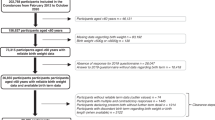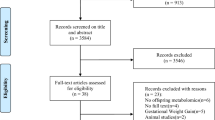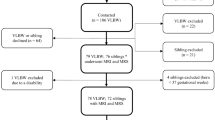Abstract
Our investigation addresses the hypothesis that disruption of third trimester development by preterm birth alters multiple biological pathways affecting metabolic health in adult life. We compared healthy adult volunteers aged 18–27 y born at ≤33 wk gestation or at term. We used whole-body MRI, 1H magnetic resonance spectroscopy (MRS) of liver and muscle, metabonomic profiling of blood and urine, and anthropometric and blood pressure measurements. Preterm subjects had greater (mean difference (95% CI)) total [2.21 L (0.3, 4.1), p = 0.03] and abdominal adipose tissue [internal 0.51 (0.1, 0.9), p = 0.007]; blood pressure [systolic 6.5 mm Hg (2.2, 10.8), p = 0.004; diastolic 5.9 (1.8, 10.1), p = 0.006]; and ectopic lipid (ratio (95% CI)), intrahepatocellular lipid (IHCL) 3.01 (1.78, 5.28) p < 0.001, and tibialis-intramyocellular lipid (T-IMCL) [1.31 (1.02, 1.69) p = 0.04]. In preterm, compared with term men, there was greater internal adipose tissue [mean (SD); men: preterm 4.0 (1.6), term 2.7 (1.1) liters; women: preterm 2.6 (0.9); term 2.6 (0.5); gender-gestation interaction p = 0.048] and significant differences in the urinary metabolome (elevated methylamines and acetyl-glycoproteins, lower hippurate). We have identified multiple premorbid biomarkers in ex-preterm young adults, which are most marked in men and indicative of risks to later wellbeing. These data offer insight into biological trajectories affected by preterm birth and/or neonatal care.
Similar content being viewed by others
Log in or create a free account to read this content
Gain free access to this article, as well as selected content from this journal and more on nature.com
or
Abbreviations
- IHCL:
-
intrahepatocellular lipid
- IMCL:
-
intramyocellular lipid
- S-IMCL:
-
soleus-intramyocellular lipid
- T-IMCL:
-
tibialis-intramyocellular lipid
References
Stevenson CJ, West CR, Pharoah PO 2001 Dermatoglyphic patterns, very low birth weight, and blood pressure in adolescence. Arch Dis Child Fetal Neonatal Ed 84: F18–F22
Irving RJ, Belton NR, Elton RA, Walker BR 2000 Adult cardiovascular risk factors in premature babies. Lancet 355: 2135–2136
Kistner A, Celsi G, Vanpee M, Jacobson SH 2005 Increased systolic daily ambulatory blood pressure in adult women born preterm. Pediatr Nephrol 20: 232–233
Doyle LW, Faber B, Callanan C, Morley R 2003 Blood pressure in late adolescence and very low birth weight. Pediatrics 111: 252–257
Hack M, Schluchter M, Cartar L, Rahman M 2005 Blood pressure among very low birth weight (<1.5 kg) young adults. Pediatr Res 58: 677–684
Johansson S, Iliadou A, Bergvall N, Tuvemo T, Norman M, Cnattingius S 2005 Risk of high blood pressure among young men increases with the degree of immaturity at birth. Circulation 112: 3430–3436
Keijzer-Veen MG, Finken MJ, Nauta J, Dekker FW, Hille ET, Frolich M, Wit JM, van der Heijden AJ 2005 Is blood pressure increased 19 years after intrauterine growth restriction and preterm birth? A prospective follow-up study in The Netherlands. Pediatrics 116: 725–731
Hovi P, Andersson S, Eriksson JG, Jarvenpaa AL, Strang-Karlsson S, Makitie O, Kajantie E 2007 Glucose regulation in young adults with very low birth weight. N Engl J Med 356: 2053–2063
Swamy GK, Ostbye T, Skjaerven R 2008 Association of preterm birth with long-term survival, reproduction, and next-generation preterm birth. JAMA 299: 1429–1436
Uthaya S, Thomas EL, Hamilton G, Dore CJ, Bell J, Modi N 2005 Altered adiposity after extremely preterm birth. Pediatr Res 57: 211–215
Thomas EL, Uthaya S, Vasu V, McCarthy JP, McEwan P, Hamilton G, Bell JD, Modi N 2008 Neonatal intrahepatocellular lipid. Arch Dis Child Fetal Neonatal Ed 93: F382–F383
Després JP, Lemieux I 2006 Abdominal obesity and metabolic syndrome. Nature 444: 881–887
Consitt LA, Bell JA, Houmard JA 2009 Intramuscular lipid metabolism, insulin action, and obesity. IUBMB Life 61: 47–55
Hagströmer M, Bergman P, De Bourdeaudhuij I, Ortega FB, Ruiz JR, Manios Y, Rey-López JP, Phillipp K, Sjöström M, HELENA Study Group 2008 Concurrent validity of a modified version of the International Physical Activity Questionnaire (IPAQ-A) in European adolescents: the HELENA Study. Int J Obes (Lond) 32: S42–S48
Matthews DR, Hosker JP, Rudenski AS, Naylor BA, Treacher DF, Turner RC 1985 Homeostasis model assessment: insulin resistance and beta-cell function from fasting plasma glucose and insulin concentrations in man. Diabetologia 28: 412–419
Katz A, Nambi SS, Mather K, Baron AD, Follmann DA, Sullivan G, Quon MJ 2000 Quantitative insulin sensitivity check index: a simple, accurate method for assessing insulin sensitivity in humans. J Clin Endocrinol Metab 85: 2402–2410
Thomas EL, Hamilton G, Patel N, O'Dwyer R, Doré CJ, Goldin RD, Bell JD, Taylor-Robinson SD 2005 Hepatic triglyceride content and its relation to body adiposity: a magnetic resonance imaging and proton magnetic resonance spectroscopy study. Gut 54: 122–127
Rico-Sanz J, Thomas EL, Jenkinson G, Mierisova S, Iles R, Bell JD 1999 Diversity in levels of intracellular total creatine and triglycerides in human skeletal muscles observed by (1)H-MRS. J Appl Physiol 87: 2068–2072
Beckonert O, Keun HC, Ebbels TM, Bundy J, Holmes E, Lindon JC, Nicholson JK 2007 Metabolic profiling, metabolomic and metabonomic procedures for NMR spectroscopy of urine, plasma, serum and tissue extracts. Nat Protoc 2: 2692–2703
Cloarec O, Dumas ME, Trygg J, Craig A, Barton RH, Lindon JC, Nicholson JK, Holmes E 2005 Evaluation of the orthogonal projection on latent structure model limitations caused by chemical shift variability and improved visualization of biomarker changes in 1H NMR spectroscopic metabonomic studies. Anal Chem 77: 517–526
Neuhäuser M, Manly BF 2004 The Fisher-Pitman permutation test when testing for differences in mean and variance. Psychol Rep 94: 189–194
Jensen MD 2008 Role of body fat distribution and the metabolic complications of obesity. J Clin Endocrinol Metab 93: S57–S63
Rasouli N, Molavi B, Elbein SC, Kern PA 2007 Ectopic fat accumulation and metabolic syndrome. Diabetes Obes Metab 9: 1–10
Vettor R, Milan G, Franzin C, Sanna M, De Coppi P, Rizzuto R, Federspil G 2009 The origin of intermuscular adipose tissue and its pathophysiological implications. Am J Physiol Endocrinol Metab 297: E987–E998
Perseghin G, Scifo P, De Cobelli F, Pagliato E, Battezzati A, Arcelloni C, Vanzulli A, Testolin G, Pozza G, Del M, Maschio A, Luzi L 1999 Intramyocellular triglyceride content is a determinant of in vivo insulin resistance in humans: a 1H–13C nuclear magnetic resonance spectroscopy assessment in offspring of type 2 diabetic parents. Diabetes 48: 1600–1606
Snijder MB, Visser M, Dekker JM, Goodpaster BH, Harris TB, Kritchevsky SB, De Rekeneire N, Kanaya AM, Newman AB, Tylavsky FA, Seidell JC 2005 Low subcutaneous thigh fat is a risk factor for unfavourable glucose and lipid levels, independently of high abdominal fat. The Health ABC Study. Diabetologia 48: 301–308
Iyer A, Fairlie DP, Prins JB, Hammock BD, Brown L 2010 Inflammatory lipid mediators in adipocyte function and obesity. Nat Rev Endocrinol 6: 71–82
Holmes E, Loo RL, Stamler J, Bictash M, Yap IK, Chan Q, Ebbels T, De Iorio M, Brown IJ, Veselkov KA, Daviglus ML, Kesteloot H, Ueshima H, Zhao L, Nicholson JK, Elliott P 2008 Human metabolic phenotype diversity and its association with diet and blood pressure. Nature 453: 396–400
Mulder TP, Rietveld AG, van Amelsvoort JM 2005 Consumption of both black tea and green tea results in an increase in the excretion of hippuric acid into urine. Am J Clin Nutr 81: 256S–260S
Nicholson JK, Holmes E, Wilson ID 2005 Gut microorganisms, mammalian metabolism and personalized health care. Nat Rev Microbiol 3: 431–438
Calvani R, Miccheli A, Capuani G, Tomassini Miccheli A, Puccetti C, Delfini M, Iaconelli A, Nanni G, Mingrone G 2010 Gut microbiome-derived metabolites characterize a peculiar obese urinary metabotype. Int J Obes (Lond) 34: 1095–1098
Yamato Y, Kimura A, Inoue T, Kurosawa T, Kato H 2001 Fetal bile acid metabolism: analysis of urinary 3 beta-monohydroxy-delta(5) bile acid in preterm infants. Biol Neonate 80: 19–25
Lucas A 1991 Programming by early nutrition in man. Ciba Found Symp 156: 38–50
Acknowledgements
We thank Giuliana Durighel and Julie Fitzpatrick (Imaging Sciences Department, Imperial College London) for technical assistance. We thank Stanislas Morin and John McCarthy (Imaging Sciences Department, Imperial College London), Sabita Uthaya (Neonatal Medicine, Imperial College), Olaf Beckonert (Biomolecular Medicine, Imperial College), and Bliss, the UK premature baby charity, for practical help.
Author information
Authors and Affiliations
Corresponding author
Additional information
Supported by the Medical Research Council and Chelsea and Westminster N.H.S. Foundation Trust.
The authors report no conflicts of interest.
Rights and permissions
About this article
Cite this article
Thomas, E., Parkinson, J., Hyde, M. et al. Aberrant Adiposity and Ectopic Lipid Deposition Characterize the Adult Phenotype of the Preterm Infant. Pediatr Res 70, 507–512 (2011). https://doi.org/10.1203/PDR.0b013e31822d7860
Received:
Accepted:
Issue date:
DOI: https://doi.org/10.1203/PDR.0b013e31822d7860
This article is cited by
-
Body composition in adults born preterm with very low birth weight
Pediatric Research (2023)
-
Abdominal adipose tissue and liver fat imaging in very low birth weight adults born preterm: birth cohort with sibling-controls
Scientific Reports (2022)
-
Prematurity and body composition at 6, 18, and 30 years of age: Pelotas (Brazil) 2004, 1993, and 1982 birth cohorts
BMC Public Health (2021)
-
Increased circulating endothelial progenitor cells (EPCs) in prepubertal children born prematurely: a possible link between prematurity and cardiovascular risk
Pediatric Research (2021)
-
Do preterm girls need different nutrition to preterm boys? Sex-specific nutrition for the preterm infant
Pediatric Research (2021)



